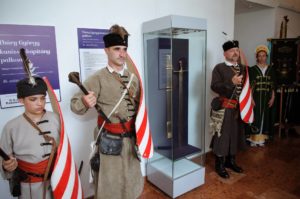Pallos

Three “pallos” swords we are talking about now. One of them is in the U.S.A. while the other one is on display in Hungary, the third is in London.
Pallache (sword, in Hungarian “pallos”) with Scabbard
Artist/maker unknown, Hungarian
(in Philadelphia Museum of Art, U.S.A.)
Geography:
Made in Hungary, Europe
Date:
1682
Medium:
Etched and partially blued and gilded steel (blade); gilded silver, wood, velvet (hilt); wood, velvet, gilded silver (scabbard)
My remark:
This weapon is called “pallos” in Hungarian and it was used on horseback. It has a straight, sometimes double-edged blade, the grip is one-handed and slanted. It was used in the wars of the “Hungaries” (Royal Hungary, Principality of Transylvania, and the Ottoman Occupied Lands of Hungary) during the 16th but mainly in the 17th century. Similar weapons were used in the Ottoman Army as well. It was not uncommon that Hungarian warriors used the excellent Eastern blades that they had got from bounty so as to use them in Hungarian fashioned swords.
The Pallos of Thury György:



(Source: Kovács S. Tibor)

You can read more about Captain Thury here:
https://www.hungarianottomanwars.com/1541-1699/1571-the-last-stand-of-captain-thury-gyorgy/
A Hungarian Pallos from Transylvania

It was made by Master Benedek of Nagyszombat (Trnava) between 1600-1640. The weapon is 108.5 cm long and 3.7 cm wide. This Pallos was sharpened not only just one side but it had a sharp section on the other side, a “fokél” that enabled it to pierce armor. This particular Pallos came from the Transylvanian Kornis family to the Károlyi family’s collection. It is on display in the Hungarian National Museum, Budapest.

Source: https://sites.google.com/site/hagyomanyesmultidezo/
Cavalry Pallos, Hungarian 1650-1700


A Pallos from the Wallace Collection:

The description of the Museum:
The hilt is comprised of an inverted cone-shaped pommel with a large button, the base faceted and of hexagonal section, the upper part decorated with interlaced basketwork, scrolls chiseled in low relief and russeted; the grip of oval section bound with shagreen; gaurd of diamond section diagonally recurved upwards and downwards respectively, one being prolonged to form a knuckle-guard; the knob on the end of the other, and those in the center of the guard and the escutcheon, are decorated with interlacements like the pommel; heart-shaped ring for the thumb, with straps extending over the grip and scabbard. On the other side, tongues extend up the grip and along the blade resembling the projections found upon hilts of Eastern origin. Broad, flat blade, double-edged with a rebated point. Scabbard covered with black leather, tooled with blind lines and fleurs-de-lys, mounted with three bands (the two upper bearing rings) and a chape, and shod with metal along the sides; the mounts are decorated with scrolls and panels of basketwork chiseled in low relief; the ground is matted with lines and has at one time been painted.
Dimensions:
- Pallash with scabbard
- Unknown Artist / Maker
- Hungary
- Date:c. 1650
- Medium: Steel, wood, leather, and ray-skin, russeted and chiseled
- Length:104 cm
- Length:87.5 cm, blade
- Width:5.2 cm
- Weight:1.605 kg, scabbard
- Weight:0.9 kg, sheath
- Source: https://wallacelive.wallacecollection.org:443/eMP/eMuseumPlus?service=ExternalInterface&module=collection&objectId=61218&viewType=detailView
Dear Readers, I can only make this content available through small donations or by selling my books or T-shirts.
If you like my writings, please feel free to support me with a coffee here:
You can check out my books on Amazon or Draft2Digital, they are available in hardcover, paperback, or ebook:
https://www.amazon.com/dp/198020490X
or at https://books2read.com/b/boYd81

“33 Castles, Battles, Legends” (Paperback) 
“The Ring of Kékkő Castle” (Paperback) My work can also be followed and supported on Patreon: Become a Patron!http://Become a Patron!
My T-shirts are available: https://hungarianottomanwars.myspreadshop.com/all




